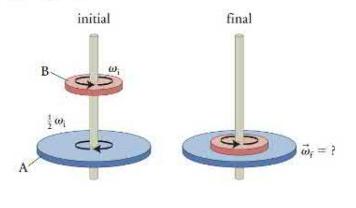Disk A in Figure (P 12.47) has radius (R_{mathrm{A}}) and thickness (h) and is initially rotating clockwise,
Question:
Disk A in Figure \(P 12.47\) has radius \(R_{\mathrm{A}}\) and thickness \(h\) and is initially rotating clockwise, as viewed from above, at \(\omega_{\mathrm{i}} / 2\). Disk \(\mathrm{B}\), made of the same material as \(\mathrm{A}\), has radius \(R_{\mathrm{B}}=R_{\mathrm{A}} / 2\) and thickness \(h\), and is initially rotating counterclockwise at \(\omega_{i}\). The two disks are constrained to rotate about the same axis, which runs through their centers. There is friction between the disks, and so once B slides down and touches A, they spin at the same rotational speed.
(a) What is their common final rotational velocity?
(b) If the frictional force is the only force that causes the system to lose energy, what is the fractional change in the kinetic energy?
Data from Figure P12.47

Step by Step Answer:






